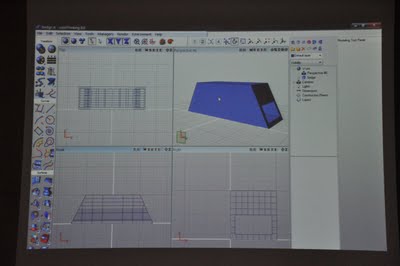This is another key area of focus for this 8.0 release, the launch of solidThinking Inspired. To set the scene, since Altair acquired the company, the two development teams have been looking at each other’s technology stacks and finding areas of cross-over – something that might seem at odds between teams responsible for a concept development tool and those working on hardcore simulation tools.
The first fruits of that cross pollination is solidThinking Inspired. To give you the background, this takes a technology from Altair developed for simulating the laws that apply to bone growth. While I’m not going to go into the detail, bone structure is developed by having a complex organic algorithm that build material to act and support the forces that occur within the structure of those bones. Essentially, nature takes on the role of optimisation and gives you a complex structure that’s typically perfectly suited to its operating parameters. The scientific theory that defines this is Wolff’s Law and implemented in a product called medical simulation product called OptiStruct. This is a field referred to as biomimicry, where technology is used to mimic the processes that occur in nature.
What the solidThinking team has done is taking this underlying tech and build a product (referred to as solidThinking Inspired) that gives the designer tools with which to run simulation on basic work envelopes and have the algorithm remove material where it’s not needed, giving you an optimised reference for further design work.
Base solid model defining working envelope and required geometric features
You start with a single solid model built within solidThinking that describes your rough work envelope. Most products conform to a basic size and form. In the case of a chair, you have supports (legs), a back and a seat. With a bridge, you have a span to cover, a platform for transfer and a spatial envelope for structural work, either above or below that platform. Once this is quickly sketched and modelled up, it’s transferred to the Inspire environment.
solidThinking Inspire has very little in the way of user interface, but does stack up multiplecommands into single icons nicely
This is a separate application and there’s very little in the way of user interface and the small smattering of icons is used to define the forces and constraints that act on that design envelope. You give it basic controls for where pressures and forces are expected to act on that design envelope, where it’s expected to be fixed and such.
Loads, restraints and such are added. you can give precise values or rough estimates – experiementation and inspiration is the name of the game here.
When you’ve defined the operating conditions, you then send the job off to calculate with an expectation in terms of percentage material removal. You choose say 25%, 30% and 50% and set it on its way. The system chunks through the work and presents back an optimised structure that enables material to be removed where stress are not present and retaining material where they’re needed to reach its performance goals in terms of structural stability.
You then have a number of tools available which allow you to explore the design, to vary material removal, trade off weight against strength and inspect the results in 3D. The results are a decimated polygon mesh which represents what the system calculates to be the optimum structure given your defined loads and constraints.
The Final result set- you can see that the system has removed material where possible and gives you back intriguing results.
That form can then be transferred back into solidThinking to be used as reference for more traditional design exploration.
The concept is that this gives you inspiration for new structures and new designers, which can then be used as the basis for further work in solidThinking. One thing that came up, considering the nature of the event we’re at and its heavy focus on simulation technologies, that people involved with simulation ask questions about mesh density, about how the results are generated. And for me, this misses the point entirely.
What solidThinking Inspired is about is giving the design community a new tool that, while it’s based on robust proven technology (as used by the likes of Airbus for optimising wing spans or leading architects, SOM, for designing high-rise buildings) its delivered in a manner that enables its use for creativity, rather than simulation. This is a tool that’s intended for finding new design alternatives, for providing, as the name suggests, inspiration, when working on new products. By bringing this type of technology, removing the complexity, but retaining the robustness, designers have the ability to research new structures for any given performance requirement and experiment further.
The fact that it’s based on OptiStruct gives you the reassurance that the structural forms it suggests are a better match to the functional requirements – you then have all of the power of solidThinking to assist with taking that form as the basis and developing a more refined product form. There is a download coming online very soon and it’s worth playing with. From having access to the beta for a few weeks now, it’s clear that there’s huge potential in this system and the results it gives you don’t always conform to how you might imagine they would. That for me is a benefit. it makes you think about what you’re designing in new and interesting ways. But to realise that, you can then push your creativity, design and engineering skills to see how that can be taken advantage of.












